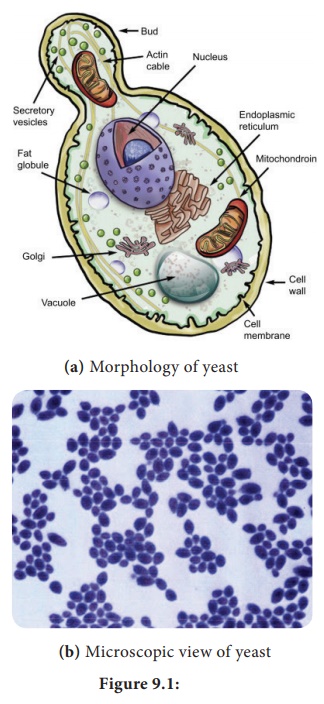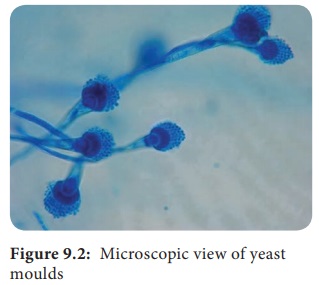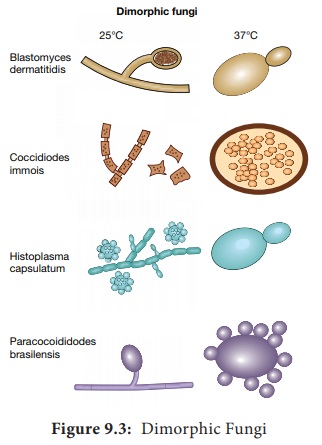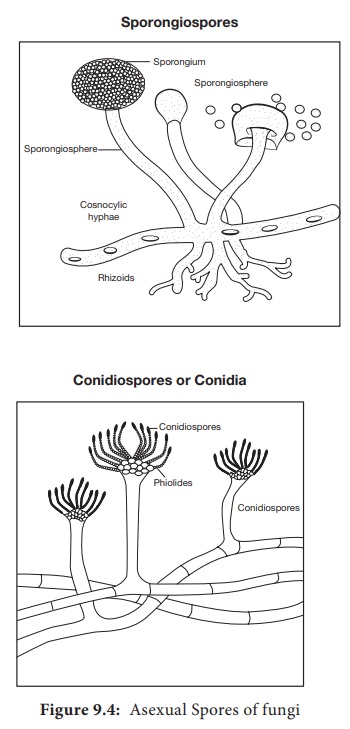Medical Mycology - Classification of Fungi based on the Host Parasitic Relationship | 12th Microbiology : Chapter 9 : Medical Mycology
Chapter: 12th Microbiology : Chapter 9 : Medical Mycology
Classification of Fungi based on the Host Parasitic Relationship
Classification of Fungi based on the Host Parasitic Relationship
Based on
the host parasitic relationship the fungi are grouped into three types.
a. Commensalism: The fungus neither gets benefit nor harmed by the host
parasitic relationship.
b. Mutualism: The fungus benefited from the host parasitic relationship.
c. Parasitism: The host is harmed by the fungus in host parasitic relationship.
Mycoses
Diseases
caused by the medically important fungi are called Mycoses. Based on their wide
spectrum of adaptability, fungi causing human mycoses can be categorized into:
a. Pathogenic fungi: The
ability of the fungi to adapt to
skin flora and cause infection.
b. Opportunistic fungi: When the immune
status of the host is reduced, fungi will induce or cause infection.
c. Toxigenic fungi: Toxins
produced by fungi are responsible
for the illness or death of patients after ingestion of the contaminated food.
d. Allergenic
fungi: Allergens are secreted by
the fungi which cause allergic reaction in the human beings.
Mycoses
are classified according to the specific site of involvement.
a. Superficial Mycoses: The infection is
limited to the outer most layers of the skin and its appendages. Example:
Malassezia and Piedra infection
b. Cutaneous Mycoses: The
infection extends deeper into the
epidermis and it also invades hair and nails. Example: Dermatophytoses.
c. Sub cutaneous Mycoses: The infection extends to dermis, subcutaneous tissue
and muscles by any traumatic injury. Example: Mycetoma
d. Systemic Mycoses:
The infection originates from lungs
and later spreads systemically to other organs. Systemic mycoses along with the
opportunistic fungal infection are known as deep mycoses. Example:
Cryptococcosis
e. Opportunistic Mycoses: The infection occurs when the immune status of the
individuals is altered. It is common among immune compromised and immune
suppressed patients. Example: Candidiasis
Aeromycology
The
Aeromycology is the study of air borne fungi, its types and the seasonal
variations of allergenic fungal spores in the environment.
There are
certain fungal pathogens which cause infections associated with workers in
mycological laboratories. To avoid this safety procedures and equipments safety
levels or bio safety levels (BSL) are used. BSL - 1 is used for low - risk
microorganisms and BSL - 4 is used for highly risk pathogens.
Infobits
Medical Mycology in India
In India, the fungal infections are known since the ancient
civilization mentioned in Aryan
documents such as Atharva Veda Mycetoma
is described as Padavamikam meaning
ant hillfoot this was observed by John Gill in Madurai district of Tamil Nadu
in 1842 which was designated as ‘Madura
foot’.
Characteristics of Fungi
Fungi are
heterotrophic organisms that exist as saprophytes, commensal or parasites. They
are found on decaying vegetative matter and also in soil. Morphological
features, cell structure, reproduction, nutritional requirement and thermal
dimorphism in the pathogenic fungi are described as follows:
i. Morphological Features
Fungi are
eukaryotic with well defined cell wall and intra cellular membrane bound
organelles. The cell wall is composed of polysaccharides and chitin. Fungi vary
in size and shape. They are broadly divided into two main groups.
a. Yeasts: The yeasts are unicellular
organisms which reproduce by asexual process known as budding or by fission.
The cell develops a protuberance that enlarges and separates from the parental
cell. The yeasts produce chains of elongated cells known as Pseudohyphae. Some yeasts reproduce by
sexual process Example: Cryptococcus neoformans.
Germ tube is special morphology found
in Candida albicans. Some are commensal without any medical significance.
b. Molds: The molds grow by apical extension, forming an interwoven mass called as Mycelium, branching filaments known as hyphae. Hyphae that grow on the surface are called vegetative hyphae. They are responsible for the absorption of nutrients. The hyphae that project above the surface are called aerial hyphae and they produce specialized reproductive structures called as conidia.
HOTS: Can you cultivate the molds at home?

Depending
on cell morphology fungi are divided into four types, they are Yeasts: These are unicellular organisms
that divide by budding (Figure 9.1a & b). Example: Cryptococcus neoformans (Pathogenic), Saccharomycescerevisiae (Non
pathogenic). Yeast – like fungi: These fungi reproduce by budding but fails to separate and hence elongation takes place
forming pseudohyphae. Example: Candida
species (Pathogenic). Molds: These
fungi produce spores which germinate to form vegetative hyphae (Figure 9.2).
Example: Dermatophytes, Aspergillus,Penicillium,
Mucor. Dimorphic fungi: These Fungi exist in both yeast at 37°C and filamentous form at
25°C. This Phenomenon is known as Fungal
dimorphism (Figure 9.3).Example: Histoplasma
capsulatum, Blastomyces dermatitidis.

Phaeoid fungi: Most of true pathogenic fungi are dimorphic fungi which are
composed of darkly coloured hyphal form known as dematiaceous fungi. Some are yeast like and also known as black
yeasts.

Vegetative Structures: Several structures are formed by the
vegetative mycelia that have no reproductive value but are important for the
differentiation of fungi eg. Chlamydospores and Arthrospores. Chlamydospores
are thick walled, resistant to adverse conditions and are larger than other
cells. Arthrospores are rectangular spores which are thick walled that are
disposed on maturity
ii. Cell structure
a. Capsule: Fungi produce an extra cellular polysaccharide in
the form of capsule. Example: Cryptococcus.
b. Cell wall: Fungi possess a multilayered rigid cell wall exterior to the plasma
lemma. The cell wall is made up of chitin, a water insoluble, homopolymer of
N-acetyl glucosamine. Chitin synthase is responsible for the bio synthesis of
chitin.
c. Plasmalemma: Cytoplasmic membrane or plasmalemma encloses complex cy-
tosol. It is composed of glycoprotein, lipids and ergosterol.
d.
Cytosol: Cytosol comprises of mitochondria, microtubules, ribosomes, golgi
apparatus, double membrane endoplasmic reticulum and Nucleus. The nuclei of the
fungi are enclosed by a membrane and contain most of cellular DNA.
iii. Reproduction of fungi
Spores
play a major role in reproduction. There may be asexual or sexual cell
divisions.
a. Asexual Reproduction: The asexual reproduction involves, budding or
fission or mitosis. Fungi produce more than one type of asexual spores. They
are microspores (microconidia) and macrospores (macroconidia). Spores that are
present inside sporangium are. known as sporangiospores
and those that are borne exogenously are called conidiospores (Figure 9.4). Based
on the arrangement of conidia they
are classified as Acropetal, Basipetal and Sympodial.

b. Sexual Reproduction: The
process of sexual reproduction
typically consists of plasmogamy (cytoplasmic fusion), Karyogamy (union of two
nuclei) and meiosis (haploid formation). Anamorphs and Telomorphs are the 2
phases of sexual reproduction
c. Mycelia Sterile: Mycelia
sterile are fast growing molds that
do not produce spores or conidia. They are medically significant fungi and are
difficult to identify
iv. Growth and nutrition
Fungi are ubiquitous in nature and grow readily in the presence of nitrogen and carbohydrates. Medically significant fungi are Mesophilic. The optimum temperature invitro for majority of the pathogenic fungi is between 25°C and 37°C. The fungi prefer acidic pH; do not require light for their growth. All fungi are heterotrophs requiring organic nutrients. They absorb their nutrient and do not ingest food. Medically significant fungi are facultative parasites, capable of causing disease or living on dead organic matter.
Related Topics